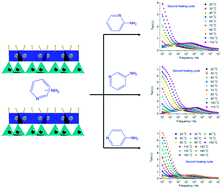Novel dielectric relaxation behaviors driven by host–guest interactions in intercalated compounds of kaolinite with aminopyridine isomers†
Abstract
Kaolinite (K), a polar and layered aluminosilicate mineral, was used as the host for three aminopyridine isomers: 2-aminopyridine (2-APy), 3-aminopyridine (3-APy), and 4-aminopyridine (4-APy). We inserted these isomers into the kaolinite interlayer to produce the intercalated compounds 2-APy-K, 3-APy-K, and 4-APy-K, respectively. These intercalated compounds show distinct ν(O–H) bands arising from the inner and inner-surface hydroxyl groups of kaolinite. They also have diverse deintercalation temperatures of about 112 °C for 2-APy-K, 136 °C for 3-APy-K, and 181 °C for 4-APy-K, indicating that the host–guest interaction is different for each of these intercalated compounds. One-step dielectric relaxation appears in 2-APy-K and 3-APy-K, while two-step dielectric relaxation appears in 4-APy-K in the low-frequency regime (f < 104 Hz). The dielectric relaxation in these compounds arises from the dipole motion of intercalatant molecules under an applied ac electrical field. Our results shed light on the design and preparation of new hybrid materials with technologically important physical properties using a host–guest chemical approach.


 Please wait while we load your content...
Please wait while we load your content...